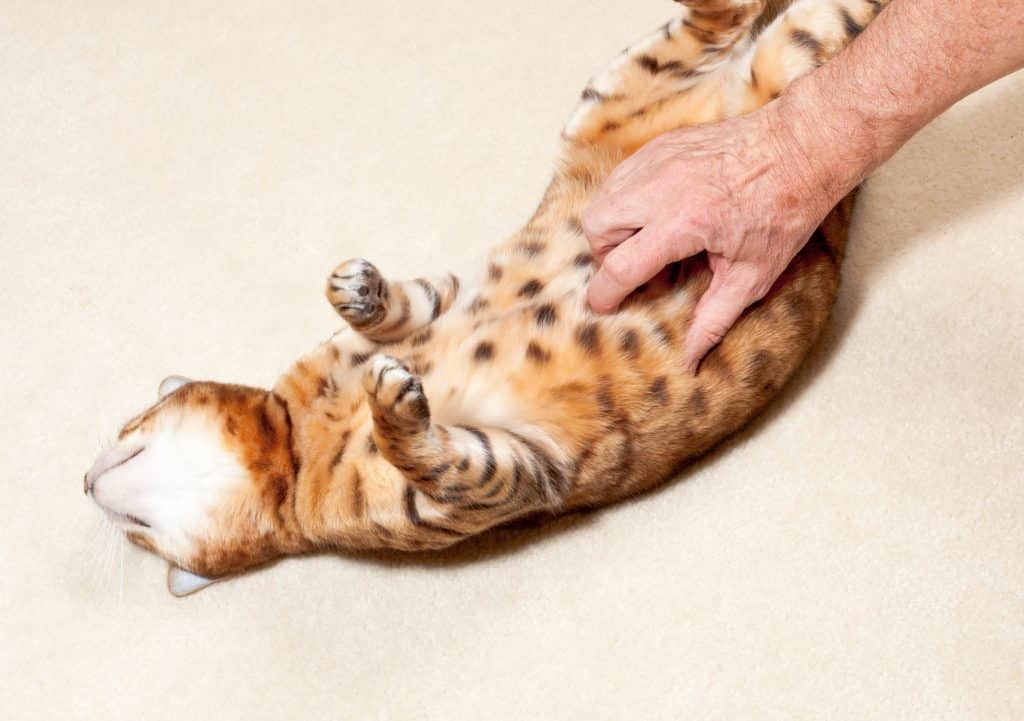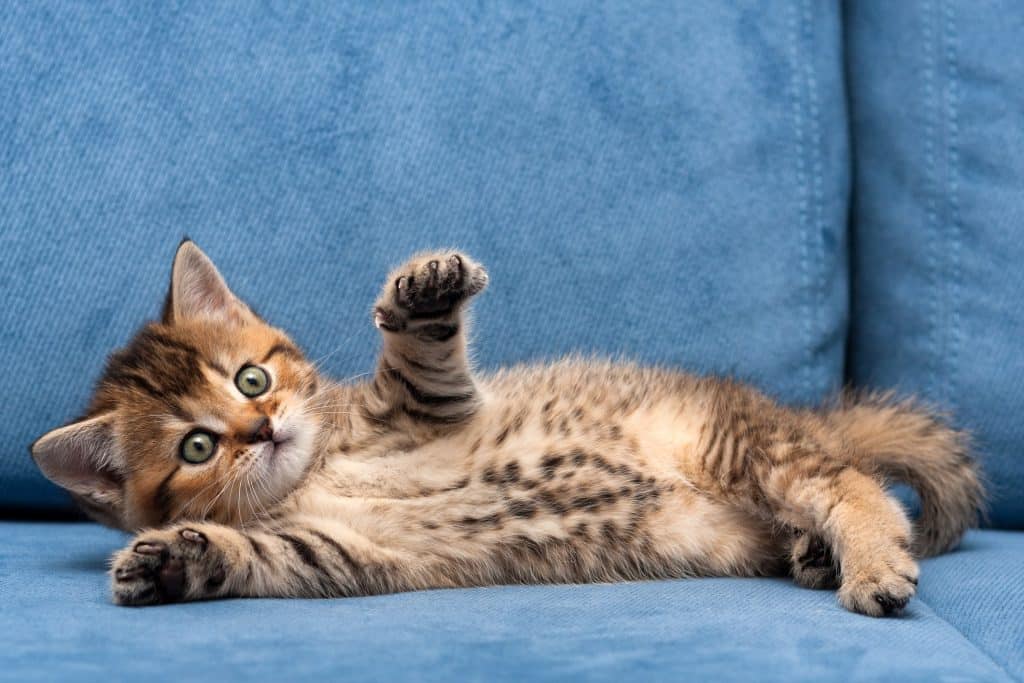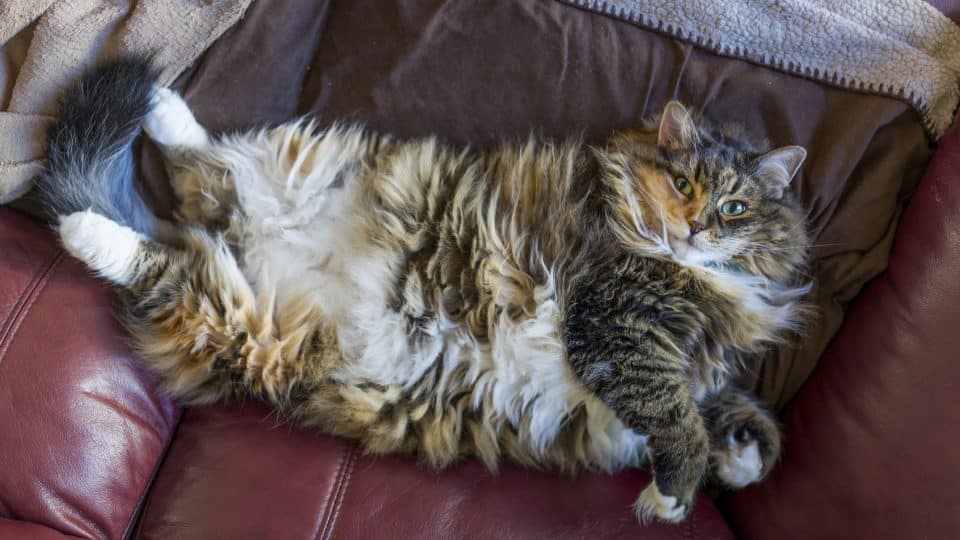When you think of a cat’s important features, you might envision their long whiskers, flicking tail, or bright eyes. But what about the swinging, saggy pouch on their underside? Also known as the belly flap, the primordial pouch is excess skin and tissue under your cat’s belly, most prominent toward the rear.
A pouch might swing side to side on round cats, average kitties, and even slim ones. All cats are born with a primordial pouch, but it may not fully develop or become noticeable until they are adults. You cannot remove a primordial pouch or make it go away as it is part of your cat’s anatomy.
Experts say the reasons why cats have this mysterious feature might be more than just a cute belly sway. In fact, theory has it that the primordial pouch may play a role in your cat’s survival.
Here’s what we found out about a cat’s signature belly flap.
Why Do Cats Have A Primordial Pouch?
A cat primordial pouch is a belly flap of extra skin and tissue. Dr. Yui Shapard, DVM and medical director at Pawp, says the reason why cats have a primordial pouch is about as fuzzy as the pouch itself. While the pouch is not a common point of discussion in the veterinary community, there are some theories bouncing around:
- Protection. One guess, says Dr. Shapard, is that the primordial pouch adds a layer of protection for vital internal organs. Whether it’s a bunny kick or defence from a predator, the extra skin and tissue guard against an injury.
- Flexibility. The primordial pouch of a cat isn’t connected to the abdominal wall, giving the pouch its signature sway when a cat walks. The extra skin of the pouch is free to stretch and lengthen—perhaps a vital role in a cat’s flexibility.
- Genetics. All cats have a primordial pouch, but Dr. Shapard says the flap may be more pronounced in some breeds.
- Weight. Bigger cats will have a primordial pouch, but the pouch is looser than fat and will sag lower, sway more, and could have fat deposits in an overweight cat.
- Age. As cats age, you’ll likely notice their primordial pouch becoming saggier—that’s normal. “Just like with us, the skin loses its elasticity as a cat ages, contributing to a more prominent primordial pouch.” Dr. Shapard says.
- Energy. Another theory is that the pouch stores excess energy or food. It’s theorised that if a cat misses a meal, they can access the extra energy stored in the tissues of the swaying belly flap. Dr. Shapard doesn’t believe this theory, given a cat’s sensitivity to missing a meal or two.

iStock/Anna Chaplygina
Do All Cats Have A Primordial Pouch?
All domestic breeds of cats have a primordial pouch, even if you think you haven’t seen one on yours. According to The International Cat Association breed standards, some domestic cats have a prominent primordial pouch while others have a less noticeable one.
| Cat Breeds Most Likely to Have A Prominent Primordial Pouch | Cat Breeds Least Likely to Have A Prominent Primordial Pouch |
| Pixie Bob | Norwegian Forest Cat |
| Egyptian Mau | Scottish Fold |
| Siberian | Thai |
| Snowshoe | |
| Bengal |
Does Spaying or Neutering Cause Cats to Have A Primordial Pouch?
A primordial pouch doesn’t develop when your cat is neutered—they’ve had their belly flap long before the procedure. But getting your cat spayed or castrated can cause them to gain weight. This weight gain, Dr. Shapard says, could cause a cat’s primordial pouch to become more pronounced.
If you’re concerned about spaying or neutering your cat due to weight gain, talk to your vet about maintaining a healthy weight after their procedure and throughout their lives.

iStock/BackyardProduction
What’s The Difference Between A Primordial Pouch & An Overweight Cat
Worried a swaying belly pouch could indicate your cat is overweight? While obesity is a serious health concern for cats, the primordial pouch is not an indicator of health. And the numbers on the scale don’t always tell the full story behind your cat’s ideal weight and body condition.
The best method of distinguishing between the primordial pouch and fat is an evaluation method that lets you visually assess your cat’s shape. “There is a useful tool called the Body Condition Score which can help you assess whether a cat is overweight or not,” Dr. Shapard explains. A healthy cat should have an hourglass shape from above and a tummy tuck with a thin fat pad toward the front of the belly.
When you feel your cat from the sides, you should be able to feel the ribs under a thin, firm layer of fat. If you can’t feel your cat’s ribs, they may be overweight. Remember, fat will be tight to the body, whereas a primordial pouch will sag and swag.
If you’re unsure if your cat is overweight, ask your vet to demonstrate the Body Condition Score evaluation at your cat’s next check up. If your cat is overweight, your vet will work with you to create a diet plan and an exercise routine.
| Signs of A Cat Who’s Overweight | Signs of A Cat at A Healthy Weight |
| A thick, firm fat pad along the underside of the belly | A primordial pouch that swings or sags |
| Round of the abdomen | Visible waist when viewed from above |
| Unable to feel the ribs | Ribs can be felt under a thin layer of fat |
| Fat deposits on the upper back | Lumbar vertebrae have a thin layer of fat |
Should my cat go on a diet to lose their primordial pouch?
A pronounced primordial pouch is not known to be linked to cardiovascular disease or diabetes, two common conditions associated with feline obesity.
If your cat is overweight, shedding a few pounds could lift the primordial pouch as a cat reaches a healthy weight. Excess weight can cause a hanging belly to hang even lower, but losing this weight will not remove a cat’s primordial pouch.

iStock/SunRay BRI Cattery RU
When to Call A Vet
When rustling your cat’s primordial pouch, it’s good practice to feel for any unusual changes like lumps or bumps. Dr. Shapard says a vet should look at a cat’s primordial pouch lump to be sure, but abnormal lumps or bumps could signal a few conditions:
- If your female cat is intact or was spayed later in life, the lump in the primordial pouch could be a developed mammary gland or a tumour in the mammary gland. Spaying before your cat’s first heat cycle stuns mammary gland development and reduces the risk of mammary gland cancer. Mammary gland cancer is less likely in males but has been reported.
- The lump could be a swollen lymph node, Dr. Shapard says. Caused by bacterial infections, fungal infections, or cancer, your cat will likely show other symptoms of illness.
- A lump could also be another type of mass so your vet should look at it as soon as possible.
“If you notice a lump in the primordial pouch, I recommend scheduling an appointment with your veterinarian to have the lump checked,” Dr. Shapard says. “You do not want to take a wait-and-see approach with a lump because if this is cancerous, early diagnosis and treatment can significantly impact their prognosis.”
If the only concern you have about your cat’s primordial pouch is that it sags and sways side to side, Dr. Shapard says that is a-okay and would recommend more kitty cuddles and belly rubs—if your feline is up for it.



